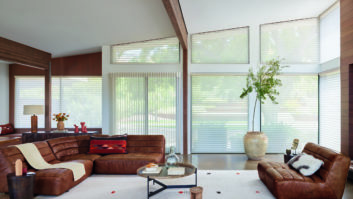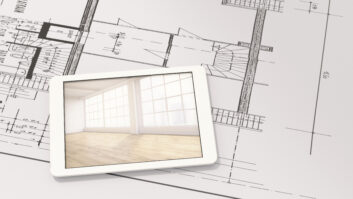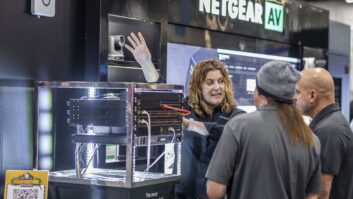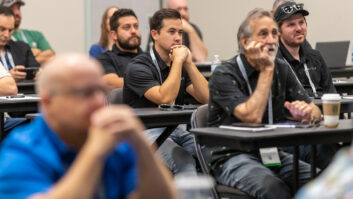Jim Beaumont, Founding Partner
HomeTech Europe, London, UK

What game-change solutions have you encountered in hidden electronics in the field?
As of late, there have been a few things that have seriously turned our industry on its head. The advent of handheld internet-connected devices: iPhone, iPad, Android devices and others. This has created a lesser need for the old hard-wired in-wall touchscreens and proprietary wireless touchscreens. This had in the past been significant source of revenue for integrators. These devices have now become an inseparable past of most people’s life, and they want the power of controlling their home and or life in the palm of their hands. In effect, hiding the old user interfaces.
We have seen a huge swing in terms of designers and clients wanting to hide the technology. This is along the lines of super-thin and lightweight LED TVs that now dominate the market. It is now easy to wall mount a TV into a slight recess and have it appear flush to the wall. The problem with these TVs is that they have terrible built-in speakers. So while you can have a flush TV, the available soundbar options are not as thin as the TVs. One of the products we have seen recently that is unique and I feel a game changer is the Niles Cynema Soundfield flush mount soundbar. The model with the built in amplifier allows for a local soundbar in situations where you could never have done it before. Prior to this, we would have to use flush-mounted speakers, but that required a remote amplifier, and that of course means running wires.
Streaming music and video sources and cloud storage has reduced the number of clients using hard storage DVD, Blu-ray, and media servers as primary sources. So no longer do you have to have a Blu-ray player sitting within easy reach of the display. And in fact, many clients no longer have any media at all.
How are you using these solutions in your own projects?
What we have begun doing during our initial client interview is determine how invasive the portable devices have become in there lives, how they listen to music and watch video. We then meet with the designers and determine how we can help reduce or eliminate speakers and interfaces from view. We have been using the Niles piece to retrofit in projects where it was impossible to pull new cables.
Luis Cortes, President
Echo Workshop, Sugar Land, TX

What game-change solutions have you encountered with hidden electronics in the field? How are you using these solutions in your own projects?
This class of offerings has grown exponentially over the past few years. Now that electronic systems are starting to be recognized as a standard in the home, and the ever-increasing desire from clients and interior designers to make the technology an aesthetically pleasing part of the home, the demand for these solutions is becoming more prevalent.
Mirrored and motorized televisions are a big hit as well, as the motorized artwork to hide televisions. Small aperture speakers and speakers systems meant to be feathered into sheet rock are now being requested as opposed to the hard sell. It should also be noted that the use of equipment rack systems is a prerequisite in the industry now. The days of having sources at each TV location are moving the same way as discs. Everything is now about distribution from a central hub within the home and the cleanliness of a simple wall hung display panel.
Lastly, we can’t ignore the psychology behind it all. Although I am still the die-hard aficionado that loves the big tower speakers, and seeing my amplifier in the middle of the floor, I recognize the market is moving into a different demand for aesthetics. WAF (Wife Approval Factor) has never before been so prevalent and IDAF (Interior Designer Approval Factor) is also creeping in. We love what we can do with our stuff, but it seems the masses don’t want to see it, and, in my opinion, manufacturers are taking notice. The luck of it all would dictate that since we are in the technology industry, we can use better technology to hide the technology they don’t want to see.
Joe Stay, Sales Engineer
Hoishik, Spring City, PA
How are you using new solutions with hidden electronics in your projects?
We have been specializing in hidden electronics for years, and we have faced concerns from clients about what happens in the future when the technology we sell them today becomes obsolete tomorrow. Will we have to tear their home apart again in five years? Will they have to spend money to repair millwork and refinish their expensive walls? At Hoishik, we’ve been able to alleviate those fears by implementing some well thought out products. For instance, the buttons on Crestron’s infiNET light switches, dimmers, and keypads can be changed on the fly in the field. When we initially install a system, we may only need a simple on/off light switch, but perhaps a year down the road the customer wants a volume control in that room. All we have to do is change the light switch faceplate and add two more buttons for volume control and make a programming change. There is no need to cut a new hole into the wall or fish new wires.
Mark Whitmire, Division Manager
Intruder Alert Systems, San Antonio, TX
What game-change solutions have you encountered with hidden electronics in the field?
The sonic quality and versatility of the TruNami subwoofer system.
How are you using these solutions in your own projects?
More and more higher end homeowners don’t want to see a big black box (subwoofer) on the floor. They find it unattractive and it takes away from their furniture placement. The TruNami in-wall subwoofer virtually disappears in a room—except, of course, when you hear it.
Brent Ratliff, Residential Sales
Logic Integration, Lone Tree, CO

What game-changing solutions have you encountered with hidden electronics in the field?
Devices like the iPort Control Mount are making it easier for us to really wow customers. Control Mount allows Apple iPad, iPad mini, or iPod touch to be used as an in-wall touchpanel providing continuous charging of the iOS device and allowing a connection to a locally available Wi-Fi network. It’s our goal to make all of the homeowners we work with aware of their options both in the design of their systems and the new technologies available on the market. I believe this device will impact how we design and install residential systems. Plus, we can integrate this device to hidden electronics just like any other standard in-wall touchpanel.
How are you using these solutions in your own projects?
Logic Integration has designed many systems with hidden electronics for an end result that the client is able to easily use and is full of cutting-edge electronics without taking away from the interior design. We work in conjunction with the interior designer to bring all the cutting edge technology into a home without overwhelming the look of the home. The iPort Control Mount is one product that has started making an appearance in our projects, both at our recommendation and customer request. We show customers how they can have total home control through products like this one, which in the long run will save them time and money.
Joshua Trujillo, Residential Sales & Design
Logic Integration, Lone Tree, CO

What game-changing solutions have you encountered with hidden electronics in the field?
Improvements on standard products we’ve worked with for a long time are continuing to change the game of residential system design and integration. Art screen lifts, drop down screens, TV mirrors, hidden speakers, and hidden cameras, for example, have been an integral part of our installations for years, but we’re seeing these products become sleeker and faster all the time. And our design center showroom at Logic Integration allows us to show potential clients all of the options they have through these technologies. We look forward to seeing how these hidden electronic products continue to evolve and define AV system design and installation.
How are you using these solutions in your own projects?
Mirror displays can sometimes be a real lifesaver. We have a residential project currently that because of layout and furnishing of the customer’s master bath, there was no workable location for a TV. The wife wanted to be able to watch programming while getting ready for the day. Due to cabinetry there was really no workable wall space. There was however, a large area set aside for a mirror. With a little preparation and some investment, we were able to do an in mirror display that worked out beautifully. With solutions provided by companies such as Séura, we were able to have programming available when the customer desired and when the display was not in use, it appeared as only a conventional mirror! Problem solved.
Stephen Berry, Senior Designer
Crescendo Designs, Southampton, NY

What game-change solutions have you encountered with hidden electronics in the field?
In regards to high-end custom AV installation, the goal often is minimization, or complete elimination of the products that we need to install (i.e. televisions, speakers, user interfaces). Depending on architecture and/or design aesthetic we have to elegantly and reliably, integrate our technologies into the available space. Mirrors double as televisions. Framed art rolls, lifts, or moves away to reveal an AV system, while lighting keypads and touchpanels are flush mounted into unique solid wall materials, such as marble, granite or hard woods.
How are you using these solutions in your own projects?
Sometimes, the simplest products can yield the most rewarding outcomes in this regard. The EDGE product is one that immediately comes to mind. Customizable to any finish, this product is not only a frame for a TV, it conceals the sides of the TV, the mount, and the wiring from view. It simply completes the installation of a TV and creates a very clean and finished look, from any angle.
At Crescendo Designs, we design AV systems. We are designers who integrate AV into homes. Having products from Media Décor by Leon Speakers at our disposal enables Crescendo to empower a project architect and interior designer to achieve their visions.
Richard Hollander, Managing Director
Performance Imaging, Stamford, CT

What game-change solutions have you encountered with hidden electronics in the field?
Performance Imaging is known for working with some of the best architects, interior designers and builders in the industry on complex and multi-layered installs.
We are consistently challenged with never encroaching these architectural statements and need to come up with ways to be heard and not seen.
How are you using these solutions in your own projects?
In doing so, we have used Sonance’s invisible series speakers in unusual ways often pairing with subwoofers behind walls, in Millwork or even behind displays. One of the things we look for is consistency and repeatability, which the invisible series provides every time. As for Trufig it’s a no brainer for it’s consistent installation techniques. In fact, on a recent project, the designer Soren Rose asked for a jamb switch for an outdoor bathroom on a rooftop in New York City with no ceiling. We installed a Lutron lighting keypad on an adjacent interior staircase with a blanked out coverplate, being that the light would go on when occupied via a jamb switch, but Lutron doesn’t make an outdoor keypad. By using the Trufig platform, we were able to make this happen without any unsightly issues in the bathroom.







